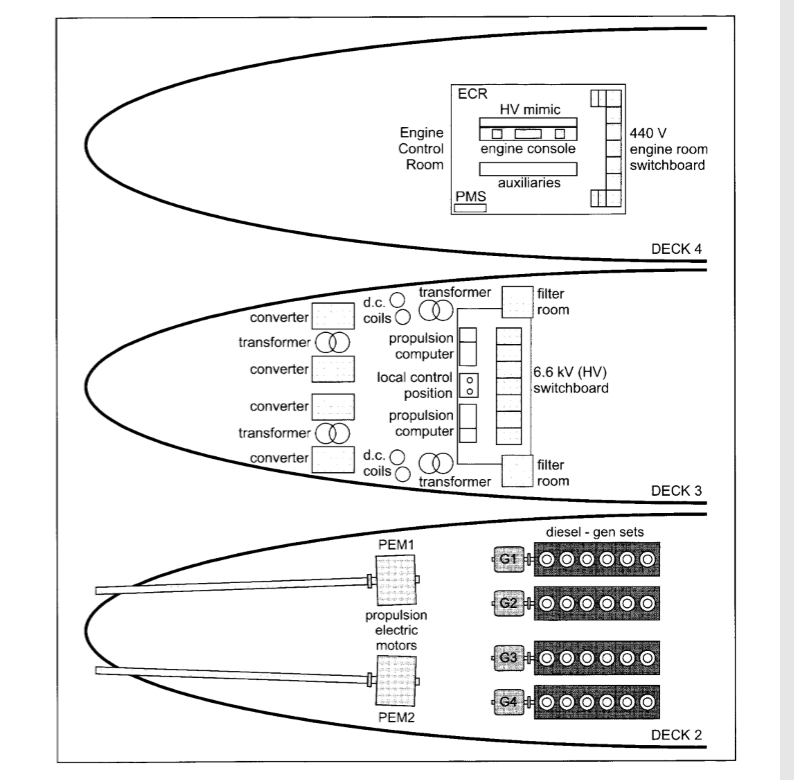Electrical propulsion on ships has been discussed in this article in detail. Electric propulsion is used mostly on passenger vessels or Cruise lines and other small vessels. But with emissions norms becoming stringent, they will make their way into merchant shipping as well.
Electrical propulsion has lot of advantages over the internal combustion engines which will be discussed in the next heading. In such system, big electrical motors get their high voltage power from the generators. High capacity generators with capacity of around 6- 10MW each is used. They can be 4-5 in numbers. Some of them can be of little less power generation capacity as compared to the other.
So we will first start with advantage of electrical propulsion and then we will move on to the actually setup as how it works.
Electric Propulsion System- Advantages
1) Low Noise and Vibration
Vibration and noise generated on the vessel are lesser as compared to the internal combustion engines. IC engines have lot of reciprocating motion and this is difficult to balance. You can reduce it, but cannot eliminate them. Since electric propulsion uses electric motor, which has no reciprocating motion, vibrations and noise generated are almost nill.
2) Ease of Control
The maneuvering capabilities are much better with use of controllable Pitch Propeller and also the fine variable speed DC motors or AC induction Motors that are available. Also they use 3-4 motors, they give better turning controls.

3) Load Diversity
Passenger ships have a huge power requirement as compared to a commercial ship. Reason is that so many systems that support passenger comfort are used. Also it is a good idea to make a central power plant which can be used for propulsion and power requirements. Such is the benefit in case of electric propulsion as power can be taken from same generators.
4) Economical Load Sharing
As the system uses a central power system, it is more economical. For example generators can be run at lesser loads if they are more in number. For example if there are 4 generators, then instead of running two on full load, one extra generator can be run and it will reduce the load on two others. So it will help in running generators at their extreme limits.
5) Layout Flexibility
Since we don’t need a main engine, generators can be put back in any place and then the power can be feed to the propulsion motors. Propulsion can fit outside the engine spaces as well.
Electric Propulsion- Complete Set up
Since now we have seen the advantages that such system gives you, it is time to see as how this system actually works. Below diagram shows the arrangement used in the electrical propulsion. You have fixed speed generators around 4 to 6 in numbers.Power generation is of high voltage and fixed frequency. But the motor needs variable frequency as per the need of the power from them. During port passages, they constantly need variable power.
To achieve such requirement large converters are used to supply variable frequency or variable voltage in case of DC motors. DC or AC induction motors can be used depending upon the power needs. Some system uses variable speed, fixed pitch propeller arrangement. While other might use the controllable pitch propellers.
Below diagram shows the kind of arrangement we can use for electrical propulsion on ship. Kind of motors that are used for propulsion have two windings, in case of need like reduced power consumption; one winding can be cut off from the supply.
Generally HV of around 6.6 KV is used which had its own advantage over low voltages like 440. You can read it here. A circuit comprising of transformers, cyclo converters etc are used to drive such motors.
Since there are various requirements by these motors like variable frequency for AC or voltages for DC, different converters are used. They are as given below
- AC- DC for DC motors using controlled Rectifiers.
- AC to AC for synchronous motors using synchroconverter
- AC-DC-AC for synchronous motors using synchroconverter.
- AC-DC-AC for induction motors using PWM – Pulse Width Modulation.
This was all from the article on electrical propulsion.
Image Courtesy: D.T HALL



